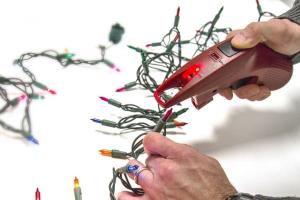Mastering Christmas Light Repair: A Comprehensive Guide for Holiday Enthusiasts

-
Quick Links:
- Introduction
- Understanding Christmas Lights
- Common Issues and Solutions
- Repairing String Lights
- Troubleshooting LED Lights
- How to Replace Bulbs
- Testing Your Lights
- Preventative Maintenance
- Case Studies
- Expert Insights
- FAQs
Introduction
Christmas lights are a cherished aspect of the holiday season, illuminating homes and bringing joy to families. However, malfunctioning lights can dampen the festive spirit. In this comprehensive guide, you'll learn how to troubleshoot and repair Christmas lights, ensuring that your holiday display shines bright.
Understanding Christmas Lights
Christmas lights have evolved significantly over the years, transitioning from traditional incandescent bulbs to modern LED technology. Understanding the differences between these types of lights is crucial for effective troubleshooting and repair.
Types of Christmas Lights
- Incandescent Lights: These bulbs produce a warm glow but are less energy-efficient and have a shorter lifespan.
- LED Lights: These are more energy-efficient, durable, and have a longer lifespan. They also come in various colors and styles.
- Solar-Powered Lights: These lights harness solar energy, eliminating the need for electricity, but their performance can be affected by weather conditions.
Common Issues and Solutions
Before diving into repairs, it's essential to identify common issues with Christmas lights:
1. Blinking Lights
Possible causes include a loose bulb or a faulty connection.
2. Dark Sections
This typically occurs when a single bulb fails, breaking the circuit for that section of lights.
3. Flickering Lights
Flickering can result from poor connections, damaged cords, or voltage issues.
Repairing String Lights
Repairing string lights can be a straightforward process if you follow these steps:
Step 1: Inspect the Entire String
Check for visible damage on the wire, sockets, and bulbs. Look for frayed wires or disconnected sockets.
Step 2: Check the Fuse
Many light strings come with a fuse. Locate the fuse box, open it, and inspect the fuse for any breaks.
Step 3: Replace Defective Bulbs
Use a bulb tester to identify faulty bulbs. Replace any broken bulbs with new ones, ensuring they match the voltage of the original bulbs.
Troubleshooting LED Lights
LED lights present unique challenges due to their sensitive circuitry. Follow these guidelines for troubleshooting:
1. Identifying Faulty Sections
Use a multimeter to check for continuity in the string. If a section is dead, it may require replacement.
2. Examining the Power Source
Ensure that the power source is functioning correctly. Test the outlet with another device to confirm.
How to Replace Bulbs
Replacing bulbs is often necessary to restore functionality to your Christmas lights. Here’s a step-by-step guide:
Step 1: Gather Materials
- Replacement bulbs
- Bulb puller (optional)
- Gloves (to protect your hands)
Step 2: Remove the Old Bulb
Carefully twist or pull out the burnt-out bulb, ensuring not to damage the socket.
Step 3: Insert the New Bulb
Align the new bulb with the socket and gently push or twist it into place. Ensure it is secure.
Testing Your Lights
Once repairs are complete, it's time to test your lights:
1. Plug in the Lights
Before hanging them, plug in the lights to ensure all sections are functioning correctly.
2. Inspect for Issues
Look for any flickering or dark sections that may indicate further issues.
Preventative Maintenance
To avoid future repairs, consider these preventative measures:
1. Proper Storage
After the holiday season, store lights in a cool, dry place, avoiding knots that can damage the wiring.
2. Regular Inspections
Before each holiday season, inspect your lights for any signs of wear and tear.
Case Studies
Here are two real-world scenarios that demonstrate successful light repairs:
Case Study 1: The Flickering LED
A family noticed their LED string lights were flickering intermittently. After testing the power source and checking connections, they identified a faulty connector which, once replaced, resolved the issue.
Case Study 2: The Dark Section
Another family discovered a dark section in their string lights. Using a bulb tester, they found multiple burnt-out bulbs. Replacing them restored the lights to full functionality.
Expert Insights
We consulted with professional electricians and holiday decorators for their top tips on repairing Christmas lights:
"Always start with the simplest solution, like checking the fuse or replacing bulbs before getting into complex repairs." - Jason, Professional Electrician
"Invest in a quality multimeter; it can save you a lot of time when troubleshooting." - Laura, Holiday Decor Expert
FAQs
1. What should I do if my Christmas lights won't turn on?
Check the fuse and ensure all bulbs are securely in their sockets. Test the outlet with another device to confirm it's working.
2. Can I use regular bulbs to replace LED bulbs?
No, you should only use bulbs that are compatible with your light string’s design and voltage.
3. How can I prevent my lights from breaking?
Store your lights properly, avoid overloading circuits, and regularly check for damage.
4. Is it safe to repair Christmas lights?
Yes, as long as you follow safety precautions, such as unplugging the lights while making repairs.
5. What type of bulb is most energy-efficient?
LED bulbs are the most energy-efficient option, consuming significantly less power than incandescent bulbs.
6. How can I tell if a bulb is burnt out?
You can use a bulb tester or visually inspect the bulb for blackened glass or breaks.
7. How long do Christmas lights typically last?
Incandescent lights last about 1,000 hours, while LED lights can last up to 25,000 hours.
8. Can I repair damaged wires?
Yes, frayed wires can be repaired with electrical tape, but if the damage is extensive, replacement is recommended.
9. What’s the best way to store Christmas lights?
Wrap them around a piece of cardboard or in a storage bin to prevent tangling and damage.
10. Should I hire a professional for repairs?
If you're uncomfortable with electrical repairs or if the damage is severe, it's best to hire a professional.